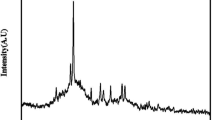Abstract
TETRACYCLINE (I) (ref. 1) and its derivatives oxytetracycline, chlortetracycline and (1-pyrrolidinylmethyl)-tetracycline2 are taken up in newly-formed bone after injection into the living organism, to form a zone that is intensely fluorescent under ultra-violet light. This reaction, which occurs wherever there is active deposition of new bone3, can be used for the detection of calcification. Because mineralized dead bone also takes up tetracycline on every surface (including, although to a lesser extent, the non-growing surfaces)4, the reaction does not depend on the activity of living bone cells or on the integrity of the physical properties of the intercellular components. Instead, there appears to be a direct reaction between tetracycline and one or more inorganic components of the mineralized tissue, the most likely species being hydroxyapatite, Ca10(PO4)6(OH)2, which is the major constituent of all such tissue5. A plausible suggestion as to the nature of the bonding involved is now offered.
Similar content being viewed by others
References
Milch, R. A., Rall, D. P., and Tobie, J. E., J. Nat. Cancer Inst., 19, 87 (1957); J. Bone Joint Surg., 40, A, 897 (1958). Rall, D. P., Loo, T. L., Lane, M., and Kelly, M. G., J. Nat. Cancer Inst., 19, 79 (1957).
Branceni, D., and Levy, J., C.R. Soc. Biol., 155, 1469 (1961).
Harris, W. H., Jackson, R. H., and Jowsey, J., J. Bone Joint Surg., 44, A, 1308 (1962).
Deleu, J., and Bohr, H., Nature, 204, 1103 (1964).
De Jong, W. F., Rec. Trav. Chim., 45, 445 (1926).
Albert, A., Nature, 177, 433 (1956).
Conover, L. H., Chem. Soc. Spec. Publ., No. 5, 48 (1956).
Kay, M. I., Young, R. A., and Posner, A. S., Nature, 204, 1050 (1964).
Posner, A. S., Perloff, A., and Diorio, A. F., Acta Cryst., 11, 308 (1958).
Hochstein, F. A., Stephens, C. R., Conover, L. H., Regna, P. P., Pasternack, R., Gorda, P. N., Pilgrim, F. J., Brunings, K. J., and Woodward, R. B., J. Amer. Chem. Soc., 75, 5455 (1953). Fields, T. L., Kende, A. S., and Boothe, J. H., J. Amer. Chem. Soc., 82, 1250 (1960).
Náray-Szabó, S., Z. Krist., 75, 387 (1930).
Author information
Authors and Affiliations
Rights and permissions
About this article
Cite this article
PERRIN, D. Binding of Tetracyclines to Bone. Nature 208, 787–788 (1965). https://doi.org/10.1038/208787a0
Issue Date:
DOI: https://doi.org/10.1038/208787a0
- Springer Nature Limited
This article is cited by
-
Bone-Targeted Dual Functional Lipid-coated Drug Delivery System for Osteosarcoma Therapy
Pharmaceutical Research (2023)
-
Drug delivery nanocarriers and recent advances ventured to improve therapeutic efficacy against osteosarcoma: an overview
Journal of the Egyptian National Cancer Institute (2021)
-
Engineered osteoclasts as living treatment materials for heterotopic ossification therapy
Nature Communications (2021)
-
Recent advances in the targeted fluorescent probes for the detection of metastatic bone cancer
Science China Chemistry (2021)
-
RETRACTED ARTICLE: Bone-targeted delivery of simvastatin-loaded PEG-PLGA micelles conjugated with tetracycline for osteoporosis treatment
Drug Delivery and Translational Research (2018)




